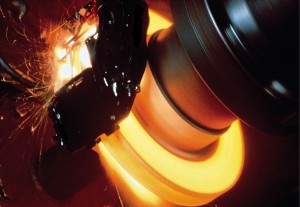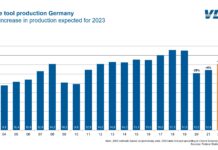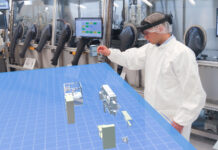
The study at stake sets the target of assessing how a small percentage of titanium inside gray iron, often deemed an impurity due to the negative effects that it exerts on the microstructure and on mechanical properties, has instead a positive effect in terms of resistance to wear and friction coefficient.
The study presented in this article is part of a project born from the collaboration between Fonderia di Torbole S.p.A. and the Department of Industrial and Mechanical Engineering of Brescia University, with the sponsorship of a doctorate course concerning a detailed characterization of the still unsolved aspects regarding the gray iron. In particular, we show the effect of the titanium concentration variation on the characteristics of resistance to wear and on the friction coefficient. Titanium is an element that is not intentionally added inside the bath, it derives from the metal charge, especially if formed by a good percentage of pig iron and it cannot be easily eliminated.
The study
They have examined two alloys with almost identical chemical composition, with the exception of the titanium concentration, which was varied by 0.013% in the case of the A alloy, by 0.027% in the B alloy. The test used to assess this property is a pin on disk test (as reported in figure 2), purposely structured to simulate the components in operation. The disk was obtained from the brake pads coming from the same case of the same manufacturing batch because, as known, brake pads are composed by different typologies of metal fibres and by an alloying element, generally a polymeric fibre, and therefore they have a very variable composition, even examining the same pad typology. The pin was instead directly obtained from the track of a brake disk cast inside Fonderia di Torbole S.p.A. with the above-mentioned composition. They obtained different cylindrical pins with 6 mm-diameter with hemispherical extremities, in order to perform a punctual contact between the cast iron pin and the disk formed by the pad. In figure 3, it is schematized the support that bears the pin and applies its load.
They carried out various preliminary tests to find the suitable testing modalities for attaining reliable results. With this machine typology, they set a distance that will be travelled by the pin in contact with the pad. The motion, however, does not occur through a displacement of the pin but through the disk rotation. In this way, they generate a circular track that, with the test progress, becomes deeper and deeper, permitting to evaluate the different layers composing the material, too. Besides the distance, a test speed is imposed, that is to say the speed with which the disk formed by the pad is set in rotation. Moreover, it is necessary to decide the force to be applied to the pin, in order to simulate at best the loading conditions of the various components in operation, permitting at the same time to appreciate the material wear and to evaluate the various wear degrees.
Initially, they decided to execute a test by setting a distance of 1000 m at a speed of 4 cm/s, applying a load of 5 N. Nevertheless, these parameters turned out to be insufficient to produce an appreciable pin wear, especially the load was too low to cause a significant wear in a gray iron. Therefore, they decided to increase the load to 15 N, keeping the other parameters unchanged (1000 m distance at a speed of 4 cm/s). With these parameters, the material wear was stronger even if, in this case too, the pin wear was minimal; it is in fact more likely that the pad wears out, by definition the consumption material. In figure 4, we can observe the two tracks left by the cast iron pins on the pad portion during this test at 1000 m, with a speed of 4 cm/s and with a load of 15N.
The traces left by pins are sensitive and the area gradually widens because the pin, wearing out, enlarges the contact surface, generating a track with a bigger surface. They decided, however, to carry out another test, even heavier, to increase the pin wear and to evaluate at best the difference between the two alloys. The weight loss shown by both alloys was anyway equal to 4 mg. Such a small weight difference is not sufficient to appreciate a possible difference in the behaviour of the two materials, therefore they opted for maintaining the same parameters of both speed and of applied load, 4 cm/s and 15N respectively, but for notable extending the test duration, increasing the distance from 1000 m to 10000 m. In the latter test, specimens are much more worn out and they allow appreciating a bigger weight difference. In figure 5, we can observe the worn-out part of the specimen made of A-alloy, with a titanium percentage of 0.027%.
However, in this case, too, the weight difference is the same both in the case of the A-alloy and in the B-alloy, corresponding to 24 mg. What notably changes between the 2 alloys is the friction coefficient value.
As we can notice in the graphs in figure 6 and figure 7, the friction coefficient in the case of the A-alloy (0.013% Ti) is about 0.42 while in the B-alloy (0.027% Ti) is higher and it reaches an average value of 0.45 approximately. We can immediately notice that, in the case of the alloy with a higher titanium percentage, we detect a higher stability in the friction coefficient with the test progress (after a first initial stabilization), in the case of the A-alloy that value is much more variable.
Conclusions
As we can observe in the graphs in the figure, it is clear that titanium seems to perform a stabilization of the friction coefficient, as well as its slight increment. This would certainly determine notable advantages during the brake disk use, since we would obtain a homogeneous behaviour of the material while braking, with the consequent higher comfort for car users.
The reason for which titanium influences and stabilizes the friction coefficient is still under study. It is known that titanium modifies the cast iron structure even in so small quantities, favouring the formation of big-size lamellas and forming very hard precipitates inside the metallic matrix of titanium nitride. The graphite produces a self-lubricating effect and therefore a higher content of this element might share in the stabilization of the friction coefficient, even if in this case a decrease of the coefficient, and not a rise of its value, would have been more understandable. Titanium nitride precipitates, instead, due to their high hardness, were expected to increase the resistance to wear of the material. As we notice in the reported graphs, the friction coefficient has slightly grown; this should have implied a higher wear of the pin, which instead was almost unaltered, making us suppose that the wear resistance in the B alloy specimen, with a titanium concentration of 0.027%, slightly improves the wear behaviour. Also considering the presence of these very hard nitrides, the material hardness in its whole decreases. This is expected to lead to a drop of the resistance to wear that anyway does not occur. Probably, the improvement determined by the better self-lubricating effect of graphite overcomes the possible decrease due to the worse hardness.







